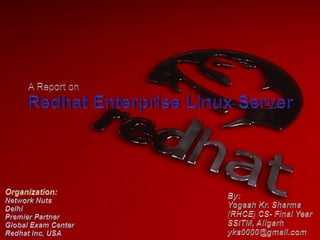
Linux: An Unbeaten Empire
- 1. A Report on Redhat Enterprise Linux Server By: Yogesh Kr. Sharma (RHCE) CS- Final Year SSITM, Aligarhyks0000@gmail.com Organization: Network Nuts Delhi Premier Partner Global Exam Center Redhat Inc, USA
- 2. Unix Unix is a multi-user, multi-tasking operating system. Many users logged into a system simultaneously, each running many programs. It's the Console based Operating system.
- 3. History of Linux/Unix First Version was created in Bell Labs in 1969. Some of the Bell Labs programmers who had worked on this project, Ken Thompson, Dennis Ritchie, Rudd Canaday, and Doug McIlroy It was given the name UNIX by Brian Kernighan. 00:00:00 Hours, Jan 1, 1970 is time zero for UNIX. It is also called as epoch. 1973 Unix is re-written mostly in C, a new language developed by Dennis Ritchie. Being written in this high-level language greatly decreased the effort needed to port it to new machines.
- 4. History of Linux Linux is a free Unix-type operating system originally created by LinusTorvalds with the assistance of developers around the world by using UNIX Source Code. It originated in 1991 as a personal project of LinusTorvalds, a Finnish graduate student. The Kernel version 1.0 was released in 1994 and today the most recent stable version is 2.6.9 Developed under the GNU General Public Licence, the source code for Linux is freely available to everyone. Various Linux Distribution like Redhat, Ubuntu, Mandrake, HP-AIX. (Redhat Known to be Market Leader)
- 6. Linux File System Table
- 7. File System The Unix file system looks like an inverted tree structure. You start with the root directory, denoted by /, at the top and work down through sub-directories underneath it. Each node is either a file or a directory of files, where the latter can contain other files and directories. The full path name starts with the root, /, and follows the branches of the file system, each separated by /, until you reach the desired file, e.g.: /home/yogesh/source/ssitm
- 8. User Group and Permission Apart from all the users, there is a special user called the root which has permission to access any file and directory. There are three permissions for any file, directory or application program. r — Indicates that a given category of user can read a file. w — Indicates that a given category of user can write to a file. x — Indicates that a given category of user can execute the file.
- 9. Basic Commands for Browsing the Linux Editors in Linux Vi Eg: vi /etc/passwd Vim Eg: vim /etc/passwd Nano Eg: nano /etc/passwd Gedit Eg: gedit /etc/passwd pwd (Present Working Directory) cd (Change Directory) ls (List Directory content) cp (Copy File) mv (Rename and Move) rm (Remove) mkdir (Make Empty Directory) touch (Create Empty File) cat (Content of file)
- 10. Terminal – A Linux Command Arena
- 11. Feature of RHEL A Number of User can login simultaneously and can run number of process simultaneously Provide multi-desktop environment Provide Name Virtual Hosting Packaging i.e. RPM ( Red hat Package Manager) Security i.e. no effect of Virus having .exe .dll and many more extension Virtual Router Networking i.e. IP Forwarding KICKSTART INSTALLATION
- 12. Linux say NO to Windows Blue Screen Error
- 13. Servers and Services in Linux Services Su Crontab Remote Desktop Network Time Protocol SSH QUOTA ACL (Access Control List) Server DNS(Domian Name Server) DHCP (Dynamic Host Conf. Protocol) FTP (File Transfer Protocols) NFS (Network File Sharing) SAMBA SERVER HTTP PROXY (SQUID) MAIL SERVER
- 14. Brief Introduction Of Servers DNS Named as Domain Name Server will convert FQDN (Fully Qualified Domain Name) to IP and vice versa Install Package: bind, bind-chroot, caching name server Config file: named.conf Port No: 53 (UDP) Service: named, network DHCP Named as Dynamic host Configuration Protocols will be used to provide IP to client system which is requesting for IP by having its MAC Address (Mandatory Access Control) or Physical Address Install Package: dhcp Config File: dhcpd.conf Port No: 67 Service: dhcpd
- 15. Contd.. FTP Named as File Transfer Protocols is used to transfer file in the network . Network may be Internet, Intranet Install Package : vsFTP (Very Secure FTP) Config File : vsftpd.conf Port No: 20(Data) , 21 (Control) (TCP/UDP) Service : vsftpd NFS Named as Network File Sharing is used to share file in the network . Network may be Internet, Intranet Install Package :nfs-utils ConfigFile : exports Service : nfs, portmap
- 16. Contd.. SAMBA Named as SAMBA is used to shared the file between Windows and Linux OS. Install Package : samba ConfigFile : smb.conf Service: smb HTTP Named as Hyper Text Transfer Protocols is used to host the web-server. Also support Name Virtual Host and work on APACHE Install Package : httpd Config File : httpd.conf Port No: 80 Service : httpd
- 17. Contd.. PROXY Named as Proxy Server is used to restrict Internet to single port. Install Package : squid Config File : squid.conf Port No: 3128, 8080 Service : squid MAIL SERVER Named as Mail Server is used to create mail server in the Network . Network may be Internet, Intranet Eg: root@xyz.com Install Package : sendmail Config File : sendmail.mc , sendmail.cf Port No:25 Service : sendmail
- 18. Major USER of Linux 95% of Banks World Wide including RBI For more: http://customers.redhat.com
- 19. THANK YOU Questions & Answers